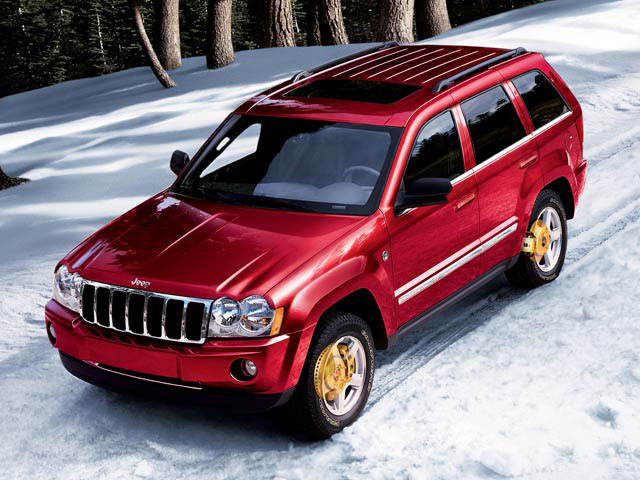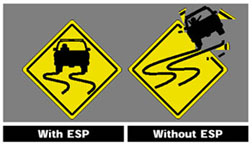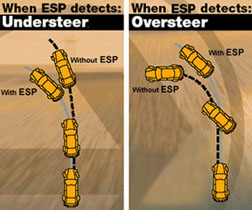Welcome to the JeepSpecs.com in-depth page on the WK Generation Jeep Grand Cherokee electronic stability program. Did we miss anything? Please get in touch with us and tell us about it!
Continental Teves’ next-generation antilock braking system, the MK25e, is making its worldwide debut on the 2005 Jeep Grand Cherokee. The MK25e is designed to prevent the wheels from locking during braking, providing increased stability and the capability to continue to steer the vehicle during hard braking. The MK25e also includes traction control (ESP), which detects wheel spin and applies the brake at the spinning wheel, effectively transferring torque to those wheels that have traction.
Electronic Stability Program (ESP) is a stability enhancement system designed to electronically detect and assist drivers in critical driving situations and under adverse conditions…automatically. Using signals from sensors throughout the vehicle, the system determines the appropriate brake and throttle adjustments for directional stability of the vehicle.
Electronic sensors are strategically placed in the vehicle, allowing ESP to analyze steering wheel activity, wheel speeds, acceleration and the vehicles’ rotation about its vertical axis (technically named yaw). During motion, the collected data is continually compared to determine whether the actual course of the vehicle corresponds to the direction the driver is steering the vehicle. If not, ESP springs into action, correcting the vehicle’s direction to coincide with where the driver is pointing it through a series of brake and engine interventions. The effect is to help correct oversteer and understeer and to coincide with where the driver is pointing the vehicle to help keep it on the road.
Continental Automotive Systems also will supply the 2005 Jeep Grand Cherokee with brake boosters and master cylinders, wheel speed sensors, and the seat heating modules.
| During Understeer:
In an understeer situation, the front end of the car tends to slide out. ESP automatically applies the inside, rear brake to help you acheive your desired turn. It may also reduce the engine’s power. During Oversteer: In an oversteer situation, the rear end of the car tends to slide out or “fishtail”. ESP automatically applies the outside, front brake to help you correct “fishtailing”. Advantages of ESP:
ESP Assists During All Driving Situations:
|
|
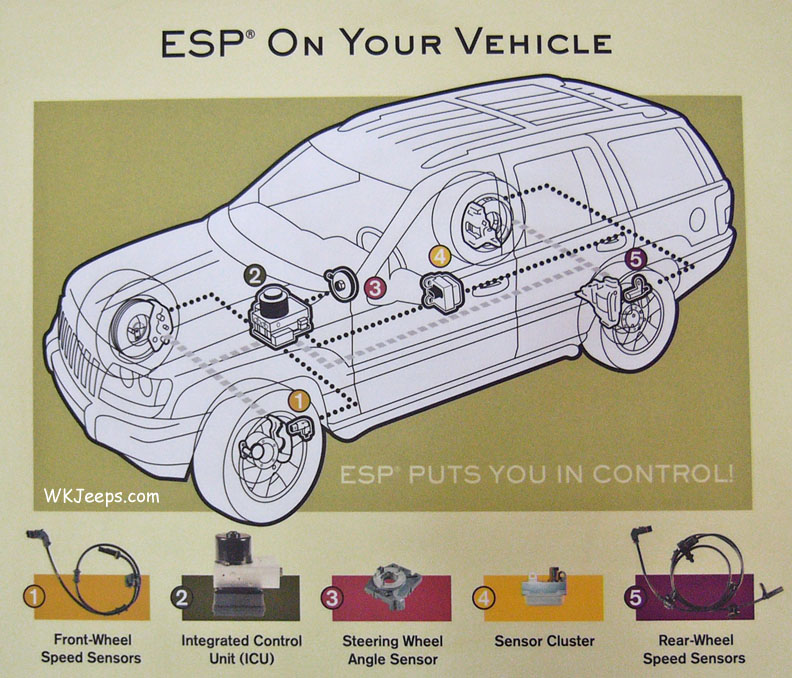
ESP functions and components
ESP operation in the WK
ESP (Electronic Stability Program) enhances directional control and reduces driving wheel spin of the vehicle under various driving conditions. ESP corrects for over/understeering of the vehicle by applying brakes to the appropriate wheel. Engine torque is also limited. The “ESP Indicator Light,” located in the instrument cluster, starts to flash as soon as the tires lose traction and the ESP system becomes active.
Chrysler introduced an additional enhancement on the all-new Jeep Grand Cherokee, an electronic rollover mitigation system that extends the ESP technology and provides enhanced vehicle stability during emergency maneuvers on all surfaces. The system observes and monitors the vehicle roll attitude and lateral force to estimate the potential for a rollover situation. If necessary, the engine torque is reduced and a short burst of full braking is applied to the appropriate wheel to help stabilize the vehicle attitude and reduce the vehicle’s lateral force.
These systems build on the Chrysler Group electronic chassis controls which include Anti-Lock Brake System (ABS) and All-Speed Traction Control (TCS). The Anti-Lock Brake System keeps the vehicle straight while retaining steering capability when braking on slippery surfaces by preventing wheel lock-up. It benefits from state-of the-art electronics that provide a more refined system response than in the past. All-Speed TCS enhances mobility and prevents wheel slip when accelerating on slippery surfaces. It also provides a measure of directional stability control — an advancement beyond prior traction control systems. Using the wheel-speed sensors, it can detect excessive yaw and help keep the car on the intended course as, for instance, when accelerating around a curve.
In addition to the brake engagement at low speeds used by conventional traction control systems, All-Speed TCS uses throttle control as well. This makes the vehicle less reliant on brake application alone to maintain traction, increases the operating speed range, and more closely modulates speed and acceleration, to provide smoother operation. With All-Speed TCS reducing engine torque when accelerating, it is possible to achieve almost seamless torque application at the wheels. All-Speed TCS also benefits from state-of-the art electronics that provide a much more refined system response than in the past.
Operation:
To turn the ESP system OFF, press the switch, located below the climate controls in the center stack, until the “ESP Indicator Light” in the instrument cluster turns on and the message “ESP SYSTEM DISABLED” appears in the Electronic Vehicle Information Center (EVIC). To turn the system back ON, press the switch a second time until the “ESP Indicator Light” turns off. ESP is always available during braking (in 4WD Hi) even if it has been switched off.
When the ESP system has been switched off, a feature of the system remains active. This feature functions similar to a limited slip differential and controls the wheel spin across an axle. If one wheel on an axle is spinning faster than the other, the system will apply the brake of the spinning wheel and allow more engine torque to be applied to the wheel that is not spinning.
To improve the vehicle’s traction when driving with snow chains, or starting off in deep snow, sand or gravel, it may be desirable to switch off the ESP by pressing the ESP switch.
With the ESP switched off, the engine torque reduction and stability features are cancelled. Therefore, the enhanced vehicle stability offered by ESP is unavailable.
If the “ESP Indicator Light” begins to flash during acceleration, ease up on the accelerator and apply as little throttle as possible. Be sure to adapt your speed and driving to the prevailing road conditions. When the “ESP Indicator Light” is illuminated continuously, the ESP is switched off. To return to the enhanced vehicle stability offered by ESP, press the ESP switch (the “ESP Indicator Light” in the instrument cluster goes out). Avoid spinning one drive wheel. This may cause serious damage to the drive train.
NOTE:
The “ESP Indicator Light” comes on momentarily each time the ignition switch is turned ON.
Each time the ignition is turned ON, the ESP System will be ON even if it was turned off previously.
The ESP Control System will make buzzing or clicking sounds when it is active.
There are two Electronic Vehicle Information Center (EVIC) messages associated with the Electronic Stability Control System:
1. ESP System Disabled
This message will be displayed if the ESP System has been turned off using the switch, or if there is a temporary condition that will result in partial or no ESP function. The “ESP Indicator Light” will be on when the system is disabled or only partial function is allowed. The “ESP SYSTEM DISABLED” message and the “ESP Indicator Light” being illuminated without the switch being depressed is not an indication that service of the electronic brake system is required.
Also, the “ESP SYSTEM DISABLED” message will be present when the vehicle is shifted into 4WD LOW.
2. Service Elec Brake System
This message will be displayed if a condition exists that may require servicing the electronic brake system. When this message is displayed and the “ESP Indicator Light” is on, there is a malfunction of the ESP System. If the “SERVICE ELEC BRAKE SYSTEM” message continues to be displayed after several ignition cycles and the vehicle has been driven several miles at speeds greater than 30 mph (48 km/h), see your authorized dealer for service.
WARNING!
ESP (Electronic Stability Program) cannot prevent the natural laws of physics from acting on the vehicle, nor can it increase the traction afforded. The ESP cannot prevent accidents, including those resulting from excessive speed in turns, or hydroplaning. Only a safe, attentive, and skillful driver can prevent accidents. The capabilities of an ESP equipped vehicle must never be exploited in a reckless or dangerous manner which could jeopardize the user’s safety or the safety of others.
ESP modes – additional information
ESP can be disengaged by the driver, causing less ESP intervention, placing more vehicle control in the driver’s hands. SRT drivers and off-road enthusiasts may wish to partially disengage the system for more spirited driving or extreme maneuvers requiring additional wheel slip, such as highspeed cornering or rapid acceleration from a standstill.
The availability of the Fully ON, Partially OFF and Fully OFF modes varies by vehicle type: normal, SRT and select 4×4 vehicles.
Normal vehicles
Normal vehicles consist of Chrysler and Dodge automobiles and 2WD SUVs. They feature two of the modes: Fully ON… and Partially OFF. ESP Fully OFF mode would not typically be offered.
SRT vehicles
SRT models (except Grand Cherokee) and police vehicles feature all three Modes: Fully ON… Partially OFF… and Fully OFF.
Select 4×4 vehicles
Select 4×4 vehicles also feature all three modes. LESS ESP intervention may be valuable in situations where some wheel slip is desirable. ESP Partial Off mode will allow for more wheel slip, while the Fully Off mode will allow for even more wheel slip by completely disabling the All-Speed Traction Control. In Fully Off mode Yaw Control and Electronic Roll Mitigation are also disabled. When the vehicle’s transfer case is in the 4LO mode, the ESP Fully Off mode is automatically engaged.
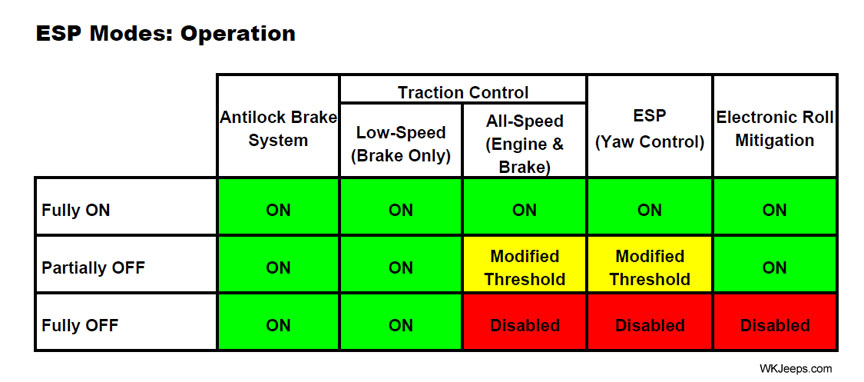
Operation modes
Fully On
Fully engaged, active ESP means all modes — all active, all the time. This is called the Fully ON mode and should be used for normal driving. The Fully ON mode completely activates the Antilock Brake System, Low-Speed Traction Control, All-Speed Traction Control, ESP Yaw Control, and Electronic Roll Mitigation. By default, whenever the vehicle is started, ESP is Fully ON or fully active.
Fully ON is automatically engaged, requiring no specific driver input. The system defaults to Fully ON each time the key is turned from the “off” to the “on” position or when shifting the transfer case on 4×4 vehicles. One push of the ESP button will put ESP back into the Fully ON mode if the vehicle is already in the Partially OFF or Fully OFF setting.
Partially OFF
The Partially OFF mode provides less automatic control by modifying the all-speed traction control and ESP yaw control thresholds. This will allow for limited wheel slip for high-performance driving situations, or driving off-road.
To select the Partially OFF mode, a single press of the “ESP OFF” button at any speed is all it takes. A warning lamp in the instrument cluster will illuminate.
Fully OFF (not available on Grand Cherokee)
The Fully OFF mode completely disables All-Speed Traction Control, ESP Yaw Control and Electronic Roll Mitigation. This mode is reserved for high-performance vehicles and off-road-capable vehicles when in four-wheel-drive mode.
To select the Fully OFF mode, press and hold the “ESP OFF” button for at least 5 seconds but not more than 14 seconds while under 10 mph. A chime will sound, a warning lamp will illuminate and a text message — ESP OFF — will appear in the instrument cluster (on vehicles with EVIC). Fully Off mode is automatically activated on 4×4 vehicles when the transfer case is shifted to 4LO mode.
When 4×4 vehicles exceed 40 miles per hour, ESP automatically switches from Fully OFF to Partially-OFF. In 4×4 vehicles, added safety is achieved by having all of ESP’s features active above 40 mph. This is not done in SRT vehicles because these vehicles are optimized for higher rates of speeds.
Note that regardless of the mode, the antilock brake system and low-speed traction control remain active — all the time.
SAFETY NOTE: Some customers may choose to remove the ESP fuse from the system to disable ESP. Removing the fuse will also disable ABS and low-speed traction control. This improper procedure will negatively affect vehicle safety and should not be done.

